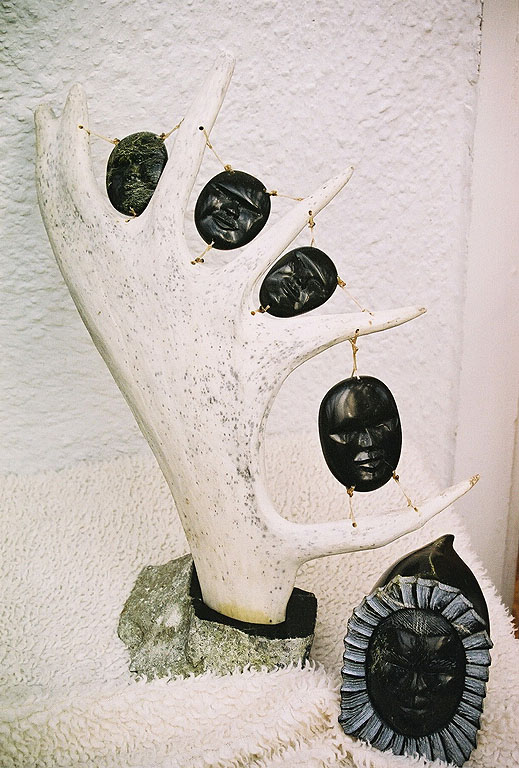

The Shaman & Antler Face by John Terriak The Shaman Ascending evokes the imagery of a traditional shaman figure chanting in the quest for spiritual ecstasy. However, in this case, the listener is placed inside of a circle of loudspeakers with the vocal utterances swirling around at high rates of speed and timbral development. The work proceeds in increasing stages of complexity as the shaman ascends towards a higher spiritual state.
The work and its title are inspired by a pair of Canadian Inuit sculptures by John Terriak with collectively the same name, as well as Inuit throat singing. All of the vocal material heard in the piece is derived from recording of the Vancouver bass singer Derrick Christian.
The Shaman Ascending was commissioned by the ZKM, Karlsruhe, Germany and premiered there in February 2005.
Note: the 8-channel version of this work was created with Richmond Sound Design's AudioBox computer-controlled diffusion system.
The Shaman Ascending is available on the Cambridge Street Records CD, Spirit Journies and the Empreintes Digitales DVD, Trans_Canada in a 5.1 format. A complete documentation analysis of the work is also available on the WSP Database (contact Barry at truax@sfu.ca for guest access).
Sound Example available
Materials:I. Bass (Derrick Christian)
Two files from Temple, one a low D, the other a multiphonic, both convolved with the impulse response for Busseto Cathedral, were used to extract 100 ms and 50 ms grains or "phonemes" with small variations in the exact location from which they were extracted. Four stereo tracks of the 100 ms grains separated by a 50 ms delay, and four stereo tracks of the 50 ms grains separated by a 50 ms delay were rotated around the 8-channel space, one phoneme per speaker, as described below. The opening of the piece brings in each 8 tracks in a sequence until all tracks are present, the effect being similar to Inuit chanting.
II. Processed Materials
Granular time stretching, sometimes with resonators, further processes the same materials, but in a continuous manner. The same spatialization scheme of rapid rotation of 8 tracks of this material animates it and prevents its broad-band nature from becoming static.
III. Bass Convolved with Self
Several of the tracks from Temple, such as those on the D & G pitches, as well as two multiphonic examples, are auto-convolved (i.e. convolved with themselves such that only their prominent harmonics are left. These are also spatially rotated such that instead of being rhythmic, they are heard as a vibrating, dynamic layer of harmonics, symbolizing the "ascent" of the shaman.
Note: All production pages, sound materials, and tracks are available on the WSP Database (contact Barry at truax@sfu.ca for guest access).
Spatialization:
CW 1 4 7 2 5 8 3 6 CW 3 6 1 4 7 2 5 8 CW 5 8 3 6 1 4 7 2 CW 7 2 5 8 3 6 1 4 CCW 2 7 4 1 6 3 8 5 CCW 4 1 6 3 8 5 2 7 CCW 6 3 8 5 2 7 4 1 CCW 8 5 2 7 4 1 6 3
Technical noteThe work was realized using Tom Erbe's SoundHack convolution program, with additional material provided by the composer's PODX system which incorporates the DMX-1000 Digital Signal Processor controlled by a PDP Micro-11 computer with software for real-time granular synthesis and signal processing developed by the composer in the School for the Contemporary Arts at Simon Fraser University. The sounds were recorded on 8-track digital tape and the AudioBox, and mixed in the Sonic Research Studio at SFU. Original impulse response file provided by Worldwide Soundspace library, some of which is now available in Peak's "Impulseverb" for OSX.